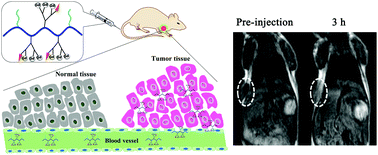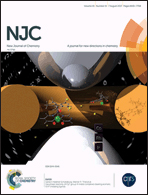PEGylated chitosan grafted with polyamidoamine-dendron as tumor-targeted magnetic resonance imaging contrast agent†
Abstract
Macromolecular contrast agents labeled with targeting ligands are now receiving growing interest in tumor-targeted magnetic resonance imaging. In this study, a macromolecular contrast agent based on PEGylated chitosan was synthesized and characterized, and its application as an MRI contrast agent was then demonstrated both in vitro and in vivo. First, the chitosan backbone was partially grafted with poly(ethylene glycol), which was used to improve the in vivo stability, followed by modifying with azide groups. Second, alkynyl-terminated PAMAM dendron modified with gadolinium diethylenetriaminepentaacetic acid (Gd-DTPA) was synthesized and conjugated onto the chitosan backbone through click chemistry. Finally, the obtained mCA was further functionalized with folic acid to improve the target specificity. The obtained FA labeled mCA exhibited higher relaxivity (9.53 mM−1 s−1) relative to Gd-DTPA (4.25 mM−1 s−1) and showed negligible toxicity as determined by the WST assay. In vivo MRI results suggested that a relatively high signal enhancement was observed in the tumor region, which made it a promising candidate for tumor-targeted MRI CA.



 Please wait while we load your content...
Please wait while we load your content...